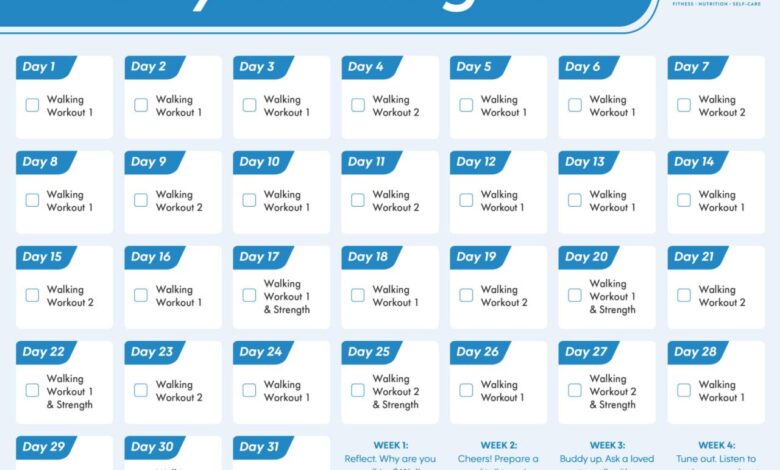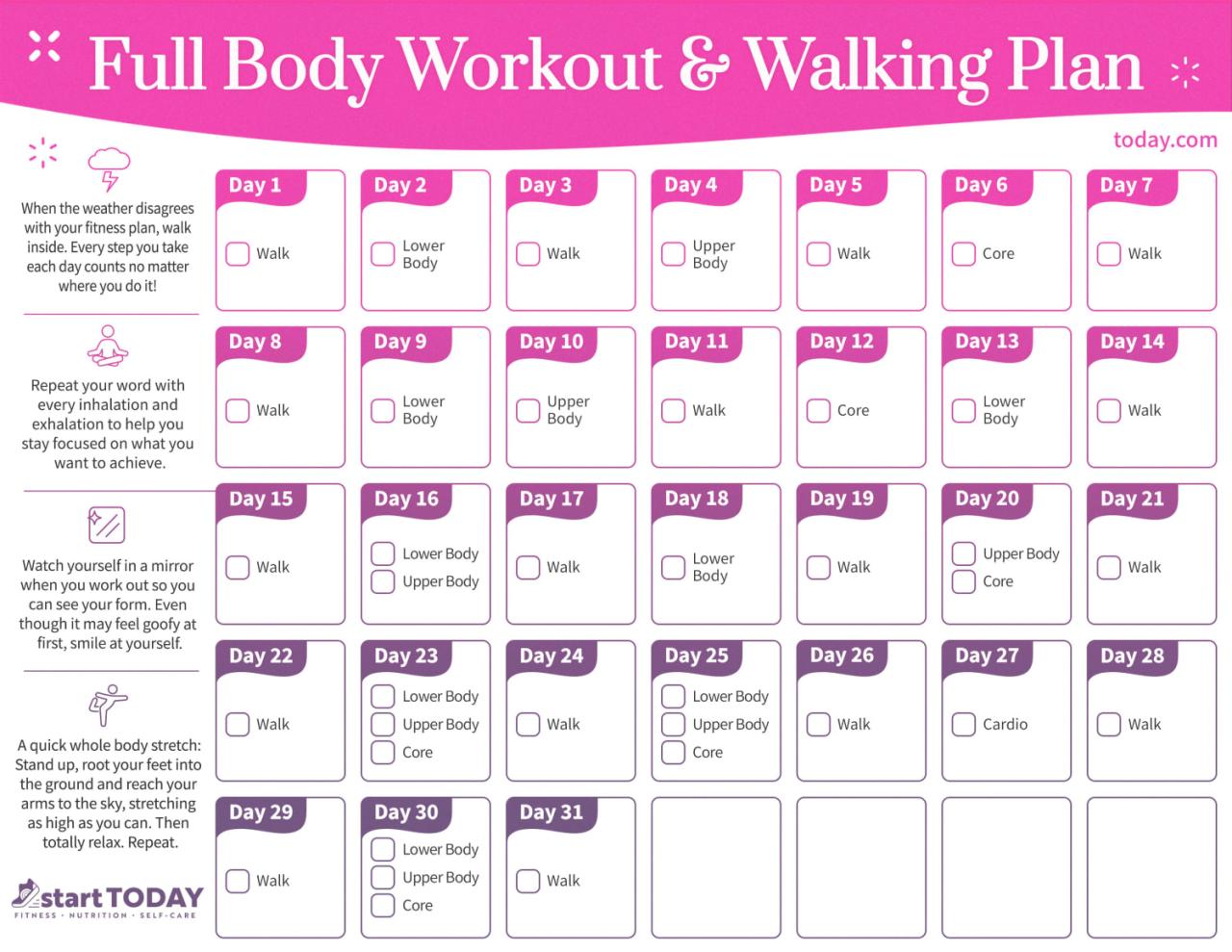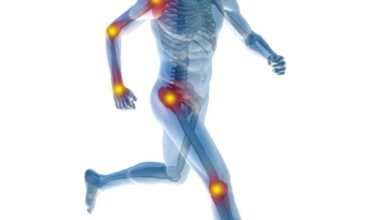
4 Week Walking Plan for Weight Loss: Your Step-by-Step Guide
Ready to ditch the gym and embrace the great outdoors for a healthier you? Our 4 week walking plan for weight loss is designed to help you shed pounds and build a sustainable fitness routine. Whether you’re a complete beginner or looking to boost your existing workout, this plan will guide you through gradual progression, increasing intensity and incorporating variety to keep you motivated and engaged.
We’ll cover everything from choosing the right shoes and perfecting your walking technique to incorporating interval training and strength exercises. Plus, we’ll provide nutrition tips, safety precautions, and motivational strategies to help you stay on track and achieve your weight loss goals.
Introduction
Walking is a fantastic way to lose weight and improve your overall health. It’s a low-impact exercise that’s easy on your joints, making it accessible to people of all fitness levels. This 4-week walking plan is designed to help you gradually increase your walking distance and intensity, leading to noticeable weight loss and improved fitness.
Importance of Consistency and Gradual Progression
Consistency is key to achieving your weight loss goals. The plan emphasizes gradual progression, allowing your body to adapt to the increased activity. This approach helps prevent injuries and ensures you stay motivated throughout the journey.
Consistency and gradual progression are crucial for sustainable weight loss and injury prevention.
Week 1: Building a Foundation: 4 Week Walking Plan For Weight Loss

This week is all about getting started and establishing a solid base for your walking journey. We’ll focus on short, manageable walks to ease your body into the routine and prepare you for more challenging walks in the coming weeks.
Walking Schedule, 4 week walking plan for weight loss
This week’s schedule is designed to gradually introduce your body to walking. It’s important to listen to your body and rest when needed.
- Day 1:15 minutes at a moderate pace.
- Day 2:Rest.
- Day 3:20 minutes at a moderate pace.
- Day 4:Rest.
- Day 5:25 minutes at a moderate pace.
- Day 6:Rest.
- Day 7:30 minutes at a moderate pace.
Choosing the Right Walking Shoes and Attire
Choosing the right walking shoes is crucial for comfort and injury prevention. They should provide adequate support and cushioning, and fit comfortably.
- Look for shoes with good arch support: This helps distribute weight evenly and prevent foot pain.
- Choose shoes with a breathable upper: This allows air to circulate and keeps your feet cool and dry.
- Consider shoes with a cushioned midsole: This helps absorb shock and protect your joints.
- Break in new shoes gradually: Don’t wear new shoes for extended periods right away.
In terms of attire, choose comfortable, breathable clothing that allows for a full range of motion. Layers are a good idea, as you can adjust your clothing based on the weather. Avoid wearing loose clothing that can get caught on things.
A 4-week walking plan for weight loss can be a great way to kickstart your fitness journey, but it’s important to consider other healthy habits as well. For instance, have you ever wondered if do cold showers offer legit health benefits ?
While research on this topic is ongoing, incorporating cold showers into your routine alongside your walking plan might be an interesting experiment. Remember, consistency is key, so stick with your walking schedule and explore other healthy choices that can contribute to your overall well-being.
Remember, it’s also essential to wear sunscreen and a hat for sun protection.
Proper Walking Techniques for Beginners
Proper walking technique is important for maximizing the benefits of your walks and preventing injuries.
- Maintain a relaxed posture: Keep your head up, shoulders back, and core engaged.
- Swing your arms naturally: This helps maintain balance and momentum.
- Land on your heel first: This helps absorb shock and prevent stress on your joints.
- Roll through your foot: As you step, roll through your foot from heel to toe.
- Maintain a consistent pace: Start at a comfortable pace and gradually increase your speed as you get stronger.
Week 3: Adding Variety and Challenge
This week, we’re going to spice things up a bit by adding some variety to your walking routine. We’ll explore different terrains and environments, making your walks more engaging and challenging. We’ll also incorporate some strength training exercises to build muscle and improve overall fitness.
A 4-week walking plan for weight loss can be a fantastic way to get moving and shed some pounds. But you might be wondering if simply standing for longer periods could also help. It’s a common question – after all, we all know that movement burns calories.
So, does standing burn enough calories to aid weight loss? This article dives into the science behind it, and while standing does burn some calories, it’s not a magic bullet for weight loss. That’s why a structured walking plan, with gradual increases in distance and intensity, is a much more effective way to achieve your goals.
Incorporating Different Terrains and Environments
By venturing beyond your usual walking route, you can challenge your body in new ways and enjoy the benefits of a more diverse workout. Here’s a sample walking schedule for Week 3:
- Monday:Flat, paved path. This will be a recovery day after the weekend’s more challenging walks.
- Tuesday:Park trails with some rolling hills. This will add a bit of incline to your walk, increasing your cardiovascular challenge.
- Wednesday:Urban walking route.
This will expose you to different environments and potentially some stairs or uneven surfaces.
- Thursday:Nature trail with moderate inclines. This will provide a good cardio workout and engage your leg muscles more.
- Friday:Flat, paved path. This will be a lighter day to recover before your weekend activities.
- Saturday:Beach walk. This will offer a change of scenery and a challenging walk in soft sand.
- Sunday:Rest day. Give your body a chance to recover and rebuild muscle.
Incorporating Strength Training Exercises
Strength training can help you burn more calories, build muscle, and improve your overall fitness. Here are some simple strength training exercises you can do alongside your walks:
- Squats:Stand with your feet shoulder-width apart and lower your hips as if you’re sitting in a chair. Keep your back straight and your core engaged.
- Lunges:Step forward with one leg and lower your body until your front knee is bent at a 90-degree angle.
A 4-week walking plan for weight loss can be super effective, especially when combined with a healthy diet. You can get creative with your meals, and salads are a fantastic way to stay full and energized. Check out some diets and recipes for meal worthy salads to inspire you.
Once you’ve got your nutrition dialed in, you’ll be ready to conquer those daily walks and reach your weight loss goals!
Push off with your front foot to return to the starting position.
- Push-ups:Place your hands shoulder-width apart on the ground and lower your body until your chest touches the ground. Push back up to the starting position.
- Plank:Hold a push-up position with your forearms on the ground and your body in a straight line from head to heels.
Hold this position for as long as you can.
Benefits of Incorporating Hills and Stairs
Walking uphill is a great way to increase the intensity of your workout. It engages more muscle groups, burns more calories, and improves cardiovascular fitness. Here are some specific benefits:
- Improved Cardiovascular Health:Walking uphill strengthens your heart and lungs, improving your overall cardiovascular health.
- Increased Muscle Strength:Walking uphill engages more muscle groups, particularly in your legs and glutes, leading to increased strength and endurance.
- Enhanced Bone Density:Weight-bearing exercises like walking uphill can help to increase bone density, reducing the risk of osteoporosis.
- Increased Calorie Burn:Walking uphill burns more calories than walking on flat ground, helping you reach your weight loss goals faster.
Week 4: Maintaining Momentum
You’ve successfully completed three weeks of walking, building a strong foundation and increasing your stamina. Now, it’s time to focus on maintaining the progress you’ve made and integrating walking into your daily routine. This week, we’ll refine your schedule, set realistic goals, and discuss the importance of making walking a sustainable habit.
Maintaining a Consistent Walking Schedule
A consistent walking schedule is key to maintaining your progress and reaping the long-term benefits of walking. Here’s a suggested schedule for Week 4:
- Monday:Rest or light activity (yoga, stretching).
- Tuesday:30-minute brisk walk, focusing on maintaining a comfortable pace.
- Wednesday:20-minute moderate walk, incorporating hills or inclines for added challenge.
- Thursday:Rest or light activity (swimming, cycling).
- Friday:30-minute brisk walk, exploring a new route or park.
- Saturday:45-minute walk, combining brisk walking with intervals of faster walking for increased calorie burn.
- Sunday:Rest or leisurely walk with family or friends.
Remember, consistency is key. Aim to walk at least four times a week, adjusting the intensity and duration based on your fitness level and goals.
Setting Realistic Goals and Tracking Progress
Setting realistic goals is crucial for staying motivated and preventing burnout. Here’s a guide to setting realistic walking goals:
- Start small:If you’re new to walking, begin with short walks and gradually increase the duration and intensity.
- Focus on progress, not perfection:Don’t get discouraged if you miss a day or two. Just get back on track as soon as possible.
- Celebrate your achievements:Acknowledge your progress and reward yourself for your efforts. This will help you stay motivated and focused.
Tracking your progress can help you stay motivated and see how far you’ve come. You can use a fitness tracker, a journal, or a simple spreadsheet to track your daily walks, distance, and time.
Incorporating Walking into a Healthy Lifestyle
Walking is an excellent form of exercise that can be easily incorporated into your daily routine. Here are some tips for making walking a sustainable habit:
- Walk during your commute:If possible, walk part of your commute to work or school.
- Take the stairs:Instead of taking the elevator, opt for the stairs whenever possible.
- Walk during your lunch break:Get some fresh air and movement during your lunch break by taking a short walk.
- Walk with friends or family:Make walking a social activity by walking with friends or family.
By incorporating walking into your daily routine, you can improve your physical and mental health, boost your energy levels, and enhance your overall well-being.
Nutrition and Hydration
Fueling your body with nutritious foods and staying hydrated is crucial for weight loss and overall health. A balanced diet provides your body with the energy it needs to power your walks and supports muscle recovery. Adequate hydration helps your body function efficiently, promotes satiety, and aids in calorie burning.
Healthy Eating Guidelines
A healthy diet for weight loss focuses on whole, unprocessed foods. These foods are naturally rich in nutrients and fiber, which helps you feel full and satisfied. Here are some key guidelines to follow:
- Prioritize fruits, vegetables, and whole grains:These foods are packed with vitamins, minerals, and fiber, which help you feel full and satisfied, promoting weight loss.
- Choose lean protein sources:Lean protein helps maintain muscle mass, which is essential for burning calories and maintaining a healthy metabolism.
- Limit processed foods, sugary drinks, and unhealthy fats:These foods are often high in calories and low in nutrients, which can contribute to weight gain.
- Control portion sizes:Eating smaller, more frequent meals throughout the day can help regulate blood sugar levels and prevent overeating.
Importance of Hydration
Water plays a vital role in weight loss. It helps you feel full, which can prevent overeating. It also helps your body burn calories more efficiently. Dehydration can lead to fatigue and cravings, making it harder to stick to your weight loss goals.
Healthy Snack and Meal Examples
Here are some examples of healthy snacks and meals that can support your weight loss journey:
Snacks
- Fruit with a handful of nuts:Provides a combination of fiber, healthy fats, and natural sugars for sustained energy.
- Greek yogurt with berries:A protein-rich snack that is also a good source of calcium and antioxidants.
- Hard-boiled eggs:A high-protein snack that can help you feel full and satisfied.
- Vegetable sticks with hummus:A low-calorie snack that provides fiber and protein.
Meals
- Salmon with roasted vegetables:A lean protein source paired with nutrient-rich vegetables for a satisfying and healthy meal.
- Chicken breast with quinoa and salad:A balanced meal that provides protein, fiber, and complex carbohydrates for sustained energy.
- Lentil soup with whole-wheat bread:A hearty and filling meal that is also low in calories and high in fiber.
Safety and Precautions

Walking is generally a safe activity, but it’s crucial to prioritize safety to prevent injuries and ensure a positive experience. Taking precautions, especially when walking in different environments, is essential for a safe and enjoyable walking journey.
Walking Safely in Different Environments
Walking in different environments can present unique challenges. Here are some tips for staying safe:
- Urban Environments:Be aware of your surroundings, especially at night. Cross at designated crosswalks, follow traffic signals, and be cautious of vehicles, especially when walking in busy areas.
- Parks and Trails:Stay on designated paths, be mindful of wildlife, and wear appropriate footwear for the terrain. Consider bringing a walking stick for balance and support, especially on uneven surfaces.
- Rural Areas:Be cautious of farm animals, stay aware of traffic, and let someone know your route and expected return time.
Potential Risks and Mitigation Strategies
Understanding potential risks and implementing mitigation strategies can significantly enhance safety during walking.
- Foot Injuries:Wear comfortable and supportive shoes designed for walking. Start with shorter distances and gradually increase your mileage to prevent overuse injuries.
- Weather Conditions:Dress appropriately for the weather. Avoid walking in extreme heat or cold, and be cautious during inclement weather such as rain or snow.
- Wildlife Encounters:Be aware of your surroundings, especially in areas known for wildlife. Make noise to alert animals to your presence and maintain a safe distance.
Listening to Your Body and Seeking Medical Advice
It is crucial to listen to your body and prioritize rest and recovery.
- Rest and Recovery:Allow your body adequate rest and recovery time between walking sessions. Listen to your body and take breaks when needed.
- Medical Advice:Consult a doctor before starting any new exercise program, especially if you have underlying health conditions. If you experience any pain or discomfort during your walks, consult a medical professional.
Results and Sustainability
This 4-week walking plan is designed to help you achieve sustainable weight loss and improve your overall health. While the plan is structured for 4 weeks, the true benefits lie in incorporating walking into your long-term lifestyle.
Potential Benefits of a 4-Week Walking Plan for Weight Loss
A consistent walking routine can contribute to significant weight loss and health improvements. Here are some potential benefits you can expect:
- Calorie Burn:Walking is an effective way to burn calories, contributing to a calorie deficit essential for weight loss. A 30-minute brisk walk can burn around 150-250 calories, depending on your weight and intensity.
- Increased Metabolism:Regular walking can boost your metabolism, leading to more calories burned even when you’re not exercising.
- Improved Cardiovascular Health:Walking strengthens your heart and lungs, reducing the risk of heart disease, stroke, and other cardiovascular problems.
- Reduced Risk of Chronic Diseases:Walking helps manage blood sugar levels, lowering the risk of type 2 diabetes, and also reduces the risk of certain cancers.
- Improved Mood and Sleep:Walking releases endorphins, which have mood-boosting effects. It also promotes better sleep quality.
- Increased Muscle Mass:Walking, especially uphill or with added resistance, can help build and maintain muscle mass.
- Improved Bone Density:Weight-bearing exercises like walking help maintain bone density, reducing the risk of osteoporosis.
Success Stories and Testimonials
Many individuals have achieved remarkable weight loss and improved health through regular walking. Here are some inspiring examples:
“I was struggling to lose weight and felt sluggish. I started with a 30-minute walk every day, and gradually increased the duration and intensity. Within a few months, I lost 15 pounds and felt more energetic than ever!”
Sarah, 42
“Walking became my stress reliever. I used to feel overwhelmed and anxious, but now I look forward to my daily walks. It’s helped me lose weight and feel more balanced overall.”
John, 35
Strategies for Incorporating Walking into a Long-Term Lifestyle
Making walking a sustainable habit requires planning and consistency. Here are some effective strategies:
- Set Realistic Goals:Start with short walks and gradually increase the duration and intensity as you get fitter. Avoid setting overly ambitious goals that might lead to burnout.
- Find a Walking Buddy:Having a walking partner can provide motivation and accountability, making it more enjoyable and likely to stick with it.
- Choose Enjoyable Routes:Explore different parks, trails, or scenic areas to keep your walks interesting and engaging. This will make you more likely to stick with it.
- Make It Part of Your Routine:Schedule walking into your daily routine, just like any other important activity. It could be a morning walk before work, a lunchtime stroll, or an evening walk after dinner.
- Listen to Your Body:Pay attention to your body’s signals and rest when needed. Avoid pushing yourself too hard, especially when you’re starting out.
- Track Your Progress:Monitor your walking distance, time, and calorie burn. This can help you stay motivated and track your progress.
- Reward Yourself:Celebrate your achievements with small rewards, such as a new pair of walking shoes or a relaxing massage.
Wrap-Up
Walking is a powerful tool for weight loss, and this 4-week plan provides a structured approach to help you achieve your goals. By gradually increasing your walking duration, intensity, and incorporating different terrains and challenges, you’ll build a solid foundation for a healthier lifestyle.
Remember, consistency is key. Embrace the journey, celebrate your progress, and enjoy the transformative power of walking.






